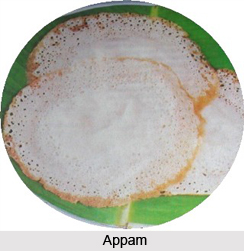 Appam is a popular dish from the Keralite repertoire of south Indian cooking. This delicious dish is loaded with nutrition and is a delight for the health conscious people. The basic ingredients of this recipe are rice and coconut milk to name a few. Appam is easy to make and can be prepared at home.
Appam is a popular dish from the Keralite repertoire of south Indian cooking. This delicious dish is loaded with nutrition and is a delight for the health conscious people. The basic ingredients of this recipe are rice and coconut milk to name a few. Appam is easy to make and can be prepared at home.
Ingredients of Appam
•2 cups raw rice
•1/2 cup cooked rice
•2 cups coconut milk
•2 tsp sugar
•1/2 tsp dry yeast
•Coconut oil or any other refined for greasing and cooking
•Salt to taste
Method of Preparing Appam
•Firstly, wash and soak the rice for 2 to 3 hours then drain.
•Now combine the soaked rice, cooked rice and half cup of coconut milk and blend in a mixer till they become smooth.
•Add the sugar, remaining one and half cups of coconut milk and salt and mix well.
•Add a little lukewarm water to the yeast and mix well.
•Add it to the rice mixture and mix well. Cover and keep aside for 2 to 3 hours.
•Heat a deep non-stick tava and grease it lightly with oil.
•Pour a ladleful of the batter into it and slowly rotate the tava in a circular motion so that a thin layer forms on the side while the middle remains thick.
•Cover and cook for a minute, remove the appam when the middle fluffy part is cooked.
•Repeat for the remaining batter to make more appams.
•Serve hot.
Another method of preparing Appam with slight change in the ingredients:
Ingredients of Appam
•1 cup raw rice
•1 cup par boiled rice
•1 tsp fenugreek seeds
•2 1/2 tbsp urad dal
•3 tbsp coconut milk
•1/2 tsp cooking soda or appam soda
Method of Preparing Appam
•Soak raw rice, par boiled rice, fenugreek seeds and urad dal for 10-12 hours.
•After 10 hours, ground it to a fine paste. Add salt and mix it well using hands. The batter should be of thinner consistency. Store it in an airtight container, leave it for another 10 hours or overnight to ferment. In the morning the appam batter would have raised nicely.
•Before making appams, add coconut milk, appam soda and mix well. Keep it aside for 10 minutes.
•After 10 minutes appam batter can be used to make soft appams.
•Take a non stick pan and coat with oil using a cloth.
•Heat the pan, and then reduce the heat to low. Now add a ladle of batter in the centre of the pan.
•Holding both the handles of the pan, rotate the pan in such a way that the batter spreads all around in a circle. The remaining batter will come to the centre.
•Now close the pan with the lid. The flame should be kept in low. Once the appam is cooked and the edges start turning brown, remove the appam from the pan.
•Serve hot.
This mouth watering recipe can be served with slightly-sweetened coconut milk and vegetable korma.




















